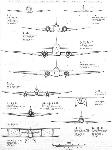
Описание
Страна : Нидерланды
Год : 1933
Единственный экземпляр
Трехместный дальний почтовый моноплан
Pander. Самолеты
<...>
Последним и, вероятно, самым знаменитым самолетом "Pander" был S.4 Postjager, скоростной почтовый аэроплан, предназначенный для использования компанией KLM на линиях в Голландской Ост-Индии. Оснащенный тремя 420-сильными (313 кВт) радиальными ПД Wright Whirlwind, он впервые поднялся в воздух 6 октября 1933 года, а первый почтовый полет в Батавию был выполнен в декабре. Приняв участие в гонках Лондон - Мельбурн, самолет с экипажем из трех человек стартовал с аэродрома Милденхолл 20 октября 1934 года и 36 часов спустя прибыл в Аллахабад, где задержался для ремонта шасси. Покидая Аллахабад 26 октября, он столкнулся с трактором, разрушился и сгорел, к счастью, экипаж остался цел.
Самолет Postjager обошелся компании "Pander" столь дорого, что в 1934 году предприятие пришлось закрыть. Но "Royal Company De Schelde" переняла часть персонала, включая главного конструктора Слота. Компания "De Schelde" построила ряд небольших самолетов, а в мае 1954 года вошла в состав "Fokker".
ТАКТИКО-ТЕХНИЧЕСКИЕ ХАРАКТЕРИСТИКИ
Pander S-4 Postjager
Тип: трехместный дальний почтовый моноплан
Силовая установка: три радиальных ПД Wright Whirlwind R-975-E-2 мощностью по 450 л. с. (340 кВт)
Летные характеристики: максимальная скорость 360 км/ч; потолок более 6050 м; дальность полета 2430 км
Масса: пустого 3200 кг; максимальная взлетная 5736 кг
Размеры: размах крыла 16,60 м; длина 12,50 м; высота 3,30 м; площадь крыла 46,00 м1
Полезная нагрузка: 500 кг
Описание:
- Pander. Самолеты
- Flight, October 1933
The "Aerial Phost"
Фотографии
-
Авиация и Космонавтика 2013-10 / В.Морозов - Великая воздушная гонка
Регистрационный номер: PH-OST [15] S-4 "Пандерягер" - несостоявшаяся надежда голландского авиапрома. Самолет сгорел через шесть дней после начала гонок
-
Air Enthusiast 1971-12 / Plane facts
Регистрационный номер: PH-OST [15] S.4 Postjager был попыткой создать скоростной почтовый самолет. Была построена только одна машина, потерпевшая аварию во время гонок на приз Макробертсона.
-
Авиация и Время 2012-02 / В.Морозов - Из Англии в Австралию: дальше уже некогда
Регистрационный номер: PH-OST [15] "Пандерягер" S.4 не оправдал надежд голландского авиапрома
-
Aeroplane Monthly 1989-09 / Personal album. Civil
Регистрационный номер: PH-OST [15] Powered by three Wright Whirlwind radial engines, Pander S.4 PH-OST was entered by a Dutch syndicate from the Hague. It carried the race number 6 on its rudder.
-
Flight 1933-09 / Flight
Регистрационный номер: PH-OST [15] Prince Henry of the Netherlands (extreme left) in front of the Pander "Postjager" on the occasion of the opening of the new clubhouse of the Amsterdam Aero Club. On Prince Henry's left is Mr. Pander, Jr.
-
Авиация и Космонавтика 2013-10 / В.Морозов - Великая воздушная гонка
Регистрационный номер: PH-OST [15] -
Flight 1933-10 / Flight
Регистрационный номер: PH-OST [15] -
Aeroplane Monthly 1989-09 / Personal album. Civil
Регистрационный номер: PH-OST [15] Comet Black Magic with the Dutch Pander S.4 PH-OST next to it.
Другие самолёты на фотографии: De Havilland Comet / D.H.88 - Великобритания - 1934
-
Air-Britain Archive 1980-01
Регистрационный номер: PH-OST [15] PH-OST was the Pander S-4 Postjager c/n 46, regd 25.11.33 and intended to open up mail routes to the East Indies. It crashed at Allahabad, India, 21.10.34, where it was earlier photographed during the MacRobertson London-Melbourne Race.
-
Air Enthusiast 1972-03 / Talkback
Регистрационный номер: PH-OST [15] The two photographs of the Pander IV at Allahabad, shortly before the accident in which it was destroyed.
-
Flight 1933-12 / Flight
Регистрационный номер: PH-OST [15] DUTCH SPEED MAIL ATTEMPT MISCARRIES: The new Dutch high-speed Pander mailplane, "Postjager," about to leave Schiphol Aerodrome at 4 a.m., December 8, in an attempt to reach the Dutch East Indies in 34 days. Unfortunately, oil trouble has held up the machine in Italy.
-
Flight 1934-10 / Flight
Регистрационный номер: PH-OST [15] A NETHERLANDS PAIR: The big Douglas DC.2 (two Wright "Cyclone" Fs) flown - with three fare-paying passengers - by K. D. Parmentier and J. J.Moll, and, behind is the Panderjager.
Другие самолёты на фотографии: Douglas DC-1 / DC-2 / C-32 / C-39 - США - 1933
-
Flight 1934-10 / Flight
Регистрационный номер: PH-OST [15] GRACEFUL - BUT UNLUCKY: A rear view of Asjes's and Geysendorfer's Panderjager (three Wright "Whirlwinds"); an undercarriage failure at Allahabad put them out of the race.
-
Авиация и Космонавтика 2013-10 / В.Морозов - Великая воздушная гонка
Регистрационный номер: PH-OST [15] Экипаж "Пандерягера" (слева направо): П. Пронк, Г. Гейзендорфер и Д. Асьес
-
Aeroplane Monthly 1989-09 / Personal album. Civil
Регистрационный номер: PH-OST [15] The Pander's second pilot D. L. Asjes and engineer snapped at Bamrauli.
-
Flight 1934-10 / Flight
There are between forty and fifty dials on the Panderjagers' instrument panel.
-
Flight 1934-10 / Flight
A case of maps and charts, complete with pencils, protractors and compasses in the Panderjager.
-
Flight 1933-09 / Flight
A model of the new Pander Mail Carrier, now under construction.
-
Flight 1934-10 / Flight
Unusual aileron arrangement on the Panderjager.
-
Flight 1934-10 / Flight
Другие самолёты на фотографии: Airspeed Courier / AS.5 - Великобритания - 1933Airspeed Envoy / AS.6 - Великобритания - 1934Boeing Model 247 - США - 1933Douglas DC-1 / DC-2 / C-32 / C-39 - США - 1933Fairey Fairey IIIF - Великобритания - 1926Koolhoven FK-41 - Нидерланды - 1928Lockheed Orion 9 - США - 1931Messerschmitt Bf.108 Taifun - Германия - 1934Miles Hawk / M.2 - Великобритания - 1932
-
Air Enthusiast 1971-12 / Plane facts
The Pander S.IV Postjager alias Panderjager was originally designed as a long-range mailplane for use by KLM and participated in the 1934 London-Melbourne Race.
- Фотографии




















